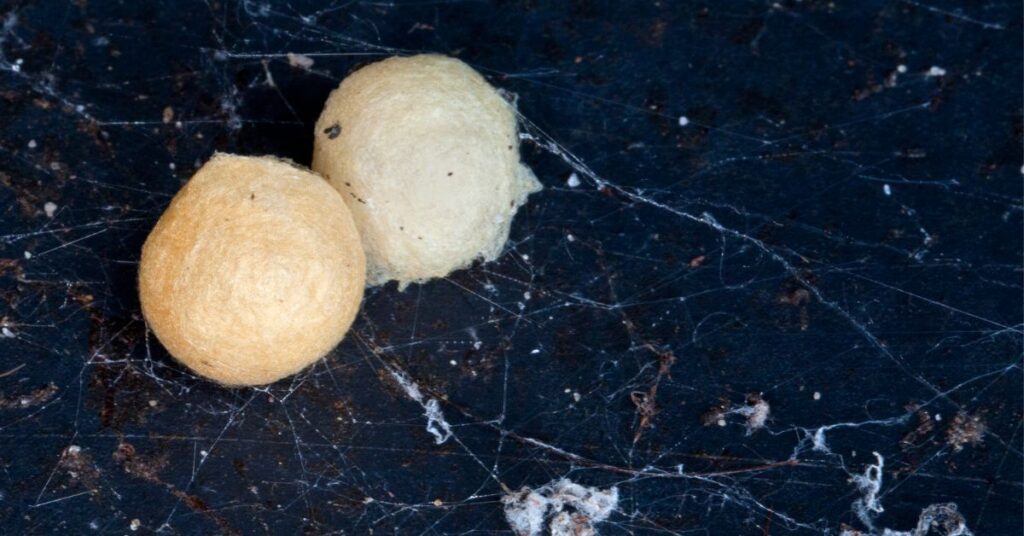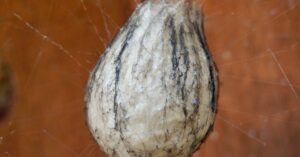
We’ve all been there (well, I have). Even though I love all things arachnid, the idea of baby spiders roaming all over my walls kind of gives me the ick. And if I feel like that, you must too! So here’s my article on where do spiders lay eggs in houses, I hope you find it helpful!
That’s not really a great deal of help. Basically put, anywhere that isn’t immediately out in the open or constantly disturbed is prime real estate for a spider. Let’s read on to find out more.
What Do Spider Eggs Look Like?

After a successful mate, most spiders will lay between 2 and 1000 eggs. That’s a lot of baby spiders to have running around your house!
They will create an “egg sac”, a protective, silken capsule from their silk in which to lay these eggs – this can vary between white, cream or even brown depending on the spider.
It can be fluffy, smooth, or even with spikes. Mostly they are round but can be oval shaped too.
Although a few spiders tie their eggs together with several strands of silk, most construct elaborate sacs of numerous layers of thick silk.
The females of many species place the egg sac on a stalk, attach it to a stone, or cover it with smooth silk before abandoning it.
Some species of spider however will carry the egg sac on their backs. The female Wolf Spider will carry her egg sacs attached to the spinnerets whilst other species drag them along on a line of silk.
What is The Gestation Period of a Spider?
A female spider will nurture the male’s sperm inside of her until she decides conditions are right to create eggs. She will produce the egg sac and after roughly 2-3 weeks, the spiderlings will hatch out.
The female wolf spider for example, instinctively bites the egg sac to permit the young to emerge after a certain length of time has elapsed.
The European cobweb spider (Achaearanea saxatile) constructs a silken thimble-shaped structure and will move the egg sac into or out of this structure to regulate egg temperature.
If a female loses an egg sac, she will make searching movements and may pick up a pebble or a piece of paper and attach it to the spinnerets.
Hatching

The young of most species are independent when they emerge from the egg sac, some female spiders even feed their young.
When food has been sufficiently liquefied by the female, the young also feed on their mother’s prey.
The female of some spiders, including one European species (Coelotes terrestris), dies at the time the young are ready to feed, and they eat her carcass.
The mother of one web spider (Achaearanea riparia) plucks threads of the web to call her young, both to guide them to food sources and to warn them of danger.
Female jumping spiders kill the male after mating to provide food for her young spiderlings.
Dispersal
When the egg has fully hatched and the spiderlings are ready to make their own way in life, either the wind or free-floating static electricity will simply pick them up and carry them away.
This is why, if you have an egg sac in your house that hatches, it will seem as though they’re everywhere as they have no-where to go.
Rest assured though, they are trying to get to the outside world, they don’t want to be there as much as you don’t want them there.
How to Get Rid of Spider Eggs in House
So you’ve identified that you do indeed have a spider egg in your house. The next step is removal.
Using a glass, simply cover the egg. Usually, mom will be nearby so if you touch the web and she hasn’t completely abandoned it, she’ll come over and you can grab her too. If placing your hand over the top of the glass to prevent her from escaping is too creepy for you, use a piece of paper or card.
Then simply dispose of them outdoors, there’s no need to kill them.
Prevention
As mentioned in a previous article, to prevent spiders entering your home in the first place, check windows and doors as much as possible for little cracks that spiders could possible crawl through and if necessary, repair them.
If you have any compost, grass clippings or compost near exterior walls, move them away slightly.
And remember, spiders are an integral part of the eco-system, they eat smaller insects and help keep the insect population on an even keel.
Finally, remember that some spiders live in our houses all year round without us even knowing.
It’s only when the male comes out to find a female to mate with, that we tend to see them (and the resulting egg sac).
After reading this article, you may be interested in reading our article on what spiders hate the most.
It has a ton of information on how to prevent spiders from entering your home or how to get rid of spiders so you shouldn’t have this problem in the first place.
